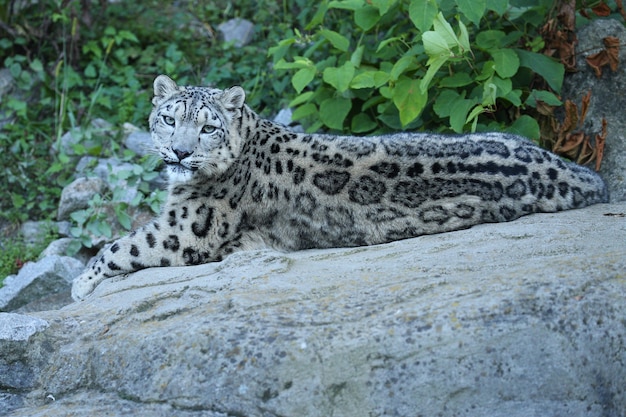

Snow leopards are native to the mountains of Central Asia.
They are one of the most elusive and mysterious large cats in the world.
Snow leopards have a unique adaptation to their habitat with their thick fur and long tail.
These big cats are perfectly adapted to living in extreme cold and high altitudes.
Snow leopards have a remarkable ability to blend into their surroundings due to their spotted coat.
They are known for their incredible agility and ability to climb steep rocky slopes.
Snow leopards are solitary animals and prefer to remain alone.
They are highly territorial and can mark their territory using scent markings.
Snow leopards are incredible jumpers and can leap up to 50 feet in distance.
Unlike other big cats, snow leopards do not roar. They communicate through hissing, growling, and moaning sounds.
These majestic creatures are also known as ghosts of the mountains due to their secretive nature.
Snow leopards are not true leopards, but they are classified under the Panthera genus.
They have a unique circulatory system that helps them conserve body heat in their extremities.
Snow leopards are classified as an endangered species with estimates of only 4,000-6,500 individuals remaining in the wild.
They have a specialized tail that helps them maintain balance during leaps and acts as a blanket to protect their face from the cold.
Snow leopards have been listed on the endangered species list since 1972.
Despite their scarcity, snow leopards play a crucial role in maintaining the balance of their ecosystem.
They primarily feed on blue sheep and ibex, which helps control population numbers and ensures a healthy ecosystem overall.
Snow leopards have extremely long and powerful hind limbs, which allow them to jump from rock to rock effortlessly.
Unlike other big cats, snow leopards have longer fur on their belly to provide extra insulation against the cold ground.
Due to their unique habitat, snow leopards have developed enlarged nasal cavities to warm the cold air before it reaches their lungs.
Snow leopards are excellent hunters and can cover long distances in search of prey, sometimes even up to 65 kilometers in a single night.
Female snow leopards have a gestation period of approximately 90-100 days.
Cubs stay with their mother until they are about 18-22 months old.
Snow leopards are highly skilled at camouflaging themselves in their environment, making them difficult to spot even for experienced wildlife observers.
They have large paws that act as natural snowshoes, allowing them to move efficiently across the snow-covered terrain.
The habitat range of snow leopards spans across 12 countries, including China, India, Nepal, Mongolia, and Pakistan.
These big cats are highly adapted to cold and can withstand temperatures as low as -40°F (-40°C).
Snow leopards have sharp, retractable claws that help them navigate steep cliffs and catch their prey.
Their long tail provides balance and stability during hunts and helps them change direction quickly while on rocky terrain.
They have a unique way of conserving energy by lowering their metabolic rate, allowing them to survive for long periods without food.
Snow leopards have keen eyesight, which helps them locate prey from a distance.
These big cats have a short muzzle and small ears to minimize heat loss in their extremely cold habitat.
They have a flexible spine that aids in their agility and enables them to make sharp turns while chasing prey.
Snow leopards have a lifespan of around 15-18 years in the wild.
They are considered a flagship species for conservation efforts, as protecting their habitat can help save many other endangered species.
Snow leopards are admired for their beauty and are often referred to as the gray ghosts due to their stunning silver-gray coat.
They are primarily crepuscular, meaning they are most active during dawn and dusk.
Snow leopards have been an integral part of the cultural heritage of the countries they inhabit, often depicted in traditional art and folklore.
Their low population density makes it difficult for researchers to study and understand their behavior and ecology.
Snow leopards are known for their ability to jump incredibly high, allowing them to catch prey that may be perched on high ledges or trees.
They have well-developed chest muscles, enabling them to cover long distances effortlessly while on the hunt.
Snow leopards can live in a variety of habitats, from shrublands and grasslands to alpine meadows and rocky outcrops.
Despite their adaptability, climate change and habitat loss have become major threats to their survival.
Conservation organizations and local communities are working together to protect snow leopards and ensure their survival for future generations to admire and appreciate.
Around the world, coffee enthusiasts enjoy Monin coffee concentrate since it is a multipurpose product. Conveniently combining…
The Importance of Choosing the Right Shower for Your Bathroom Renovating your bathroom can be…
Usain Bolt holds the record for the fastest 100-meter sprint in history.Bolt was named Sportsman…
Love is in the air... and it smells suspiciously like chocolate!Roses are red, violets are…
Life's a beach, take a picture and relax.Sun, sand, and salty kisses. That's what beach…
Hungary is home to the largest thermal water cave system in the world.The Rubik's Cube…